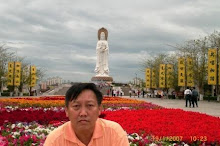
 My elder sister, Lai Meng, my younger sister, Lai Ling & myself, HK Wan travelled from Jiangmen to Cuiheng Village. We took the bus from Jiangmen Station to Zhongshan @ RMB 16/person and from there. we boarded Bus No. 12 to The Museum of the Former Residence of Dr. Sun Yat-Sen, Cuiheng Cun. The journey took about 1 hour and the fare was RMB 5.50 per person. You can never miss this place as the Museum is on the main road and can be clearly seen from the bus stop.
My elder sister, Lai Meng, my younger sister, Lai Ling & myself, HK Wan travelled from Jiangmen to Cuiheng Village. We took the bus from Jiangmen Station to Zhongshan @ RMB 16/person and from there. we boarded Bus No. 12 to The Museum of the Former Residence of Dr. Sun Yat-Sen, Cuiheng Cun. The journey took about 1 hour and the fare was RMB 5.50 per person. You can never miss this place as the Museum is on the main road and can be clearly seen from the bus stop.On the day, 21/3/09, we were surprised that the entrance charges was free-of-charge, perhaps to commemorate Dr. Sun's death anniversary on 12 March 1925. The previous trip, I visited here was almost 4 years ago on 1st July 2005. I came with my octogenarian father and my elder brother and we were taking my father back to our Ancestral Hometown at Jiangmen, Guangdong. We came by mini bus from Gongbei @ RMB 10/person and the mini bus stopped right in front of The Museum of the former residence of Dr. Sun. At that time, the entrance fee was RMB 20 each for my elder brother & myself whereas my elderly father need not pay any entrance fee at all.
This museum is the most visited touristic site within Zhongsan Perfectural City. No trip to Zhongshan is complete without a visit here. Dr. Sun Yat-sen was born in Cuiheng village in 1866. He headed the Chinese Revolution that overthrew the Qing dynasty in 1911 and was sworn in as the Provisional President of The Government of The Republic of China on 1st January 1912. He also co-founded the Kuomintang (KMT) where he served as its first leader. He was also a uniting figure in post-Imperial China and well revered in both Mainland China, Taiwan and by overseas Chinese in Hong Kong, Macau, Singapore, Malaya, Thailand, Indonesia, America, etc.
The Museum of Dr. Sun Yat-sen, consisting of the Former Residence of Dr. Sun Yat-sen, Sun Yat-sen Memorial Hall, Cuiheng Folk House Exhibition and the Cuiheng Farming Exhibition, is a national protected cultural site to commemorate Dr. Sun Yat-sen.
The Former Residence of Dr. Sun Yat-sen
The Former Residence of Dr. Sun Yat-sen is a distinctive two-storey building. Dr. Sun lived here from 1892 to 1895, when he practiced medicine and engaged in revolutionary activities in the Pearl River Delta. There are many legacies about Dr. Sun’s childhood, his family, and his early education. The Former Residence is maintained exactly the same as the original look. In 1986, the Former Residence of Dr. Sun Yat-sen was ranked by the State Department “National Protected Cultural Site”.
Sun Yat-sen Memorial Hall
This Memorial Hall was built with the 40 million yuan raised by the municipal government and upon the approval of the State Administration of Cultural Relics. On exhibition here are the valuable historical photos and real objects reflecting the life of Sun Yat-sen. Equipped with advanced equipment, this is a modern multifunctional exhibition hall. The exhibition hall provides fascinating insights into the history of Chinese nationalism and an introduction to Dr. Sun Yat-sen’s life story, deeds, personality, thought and theory and revolutionary activities under his leadership. On the second floor is the exhibition of “Dr. Sun Yat-sen’s Relatives and Descendants”, reflecting their great support and contribution to the revolution and their sacrifice for the revolution led by Dr. Sun. The second floor also has rooms for temporary exhibitions.
 Photographs of myself taken at Dr. Sun Yat-sen Memorial Hall
Photographs of myself taken at Dr. Sun Yat-sen Memorial HallPhotograph of China's most famous "Soong Sisters" taken at Dr Sun Yat-sen's Memorial Hall.
The 3 sisters, namely the eldest, Soong Ai-ling, the second sister, Soong Ching-ling and the youngest, Soong Mei-ling were the daughters of American educated Methodist Minister, Mr. Charlie Soong who made a fortune in banking and printing. Their mother was Ni Kwei-tseng.
In the 1930s, Soong Ai-ling and her sister, Mei-ling were the two richest women in China at that time. Both of them supported the Nationalists, while Soong Ching-ling later sided with the CPC. Eldest Sister, Ai-ling was the one who loves "money", she married the richest man and Finance Minister in China, H.H. Kung.
Ching-ling was the one who loves "China" was married to Dr. Sun on 25 October 1915. In the later years, she was a Vice Chairman of The Peoples Republic of China. She was the first non-royal woman to officially become head of state of China, acting as Co-chairman of the Republic from 1968 until 1972. She again became head of state in 1981, briefly before her death ( 29 May 1981), as President of China. Soong Ching-ling is sometimes regarded as Asia's first female head of state, although her title of Honorary President of the People's Republic of China was purely ceremonial.
Mei-ling was the one who loves "power". She was a prominent political leader in her own right, the wife and partner in power of the leader of the Kuomintang (KMT) , Generalissimo of the Chinese armies, and later President Chiang Kai-shek.
Posted by HK Wan, May 2009

